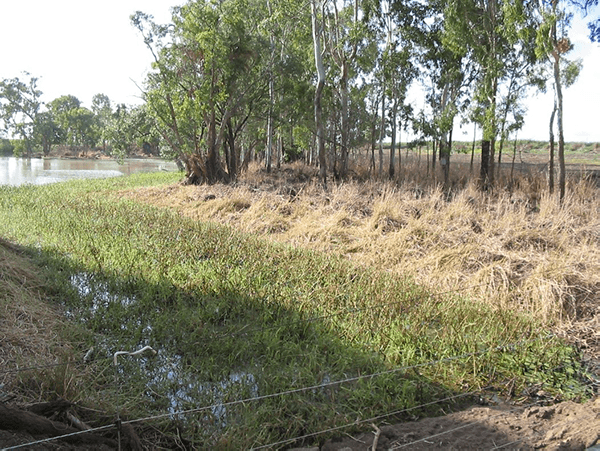|
|
Fire regime managementFire can have a major effect on the condition of riparian vegetation. Management of the fire regime can be a significant management tool for any rehabilitation objectives that include the condition of riparian vegetation. Bushfires are generally less frequent in riparian zones than nearby upland areas. The way fire affects riparian zones is highly variable and can be influenced by several factors including fire frequency and intensity, width of the riparian zone, the degree to which the local vegetation is fire resistant and antecedent conditions such as drought. Riparian communities are adapted to differing fire regimes depending on their location, composition, soils and climatic conditions. While riparian vegetation communities in more humid/high rainfall areas, (e.g. riparian vegetation in a rainforest) may be more sensitive to damage from excessive/hot burns, riparian communities in seasonally dry areas are adapted to intense fires and can regenerate (e.g., release of seeds from woody fruits, seed germination, heat/smoke to break seed dormancy, stimulation of flowering, and resprouting from epicormic buds underneath their bark or from rootstock). Fire regime is the pattern of fire occurrence for an area (frequency and intensity). Fire regimes can be ‘hot’ or ‘cool’, frequent, or infrequent and for some sensitive communities (e.g. rainforest) total fire exclusion is the most desirable fire regime. Fires that occur too frequently, should be avoided as they will tend to promote weeds rather than native species that take longer to flower and set seed. Methods to manage fire regime include identification of the appropriate regime for the vegetation community. Methods can include seeking cultural burn advice, establishment of fire breaks, management of fire fuel loads (e.g. through slashing or grazing) and setting of controlled (planned) burns. To conduct a planned burn, a written permit from a fire warden is essential, through contacting the local Rural Fire Service. Across Queensland, the fire regime experienced by vegetation communities including riparian areas has been modified and/or affected by a range of factors including aspect, season, grass fuel loads, weed invasion, drought, canopy gaps (drying of soils and fuel loads), clearing, encroachment of more intensive land uses and public attitudes. Within riverine and riparian ecosystems fire most commonly occurs in bank side vegetation. In some instances, this includes areas within the channel in addition to adjoining high bank areas. In seasonal river systems fire can sometimes be carried by senescent grasses and macrophytes growing on the riverbed. The ideal fire regime for different zones (e.g. the ecotonal margins of elevated bank areas versus within channel areas) can be distinct and this can be compromised where canopy clearing and/or weed infestation has impacted fire fuel loads and fire refuge boundaries. Fire can also affect rivers and wetlands by increasing erosion and sedimentation. In the dry tropics particularly, fires late in the dry season have been shown to increase sediment loads in adjacent rivers and can increase sediment deposition in wetlands. Therefore, proactive fire management across an entire subcatchment may be an important intervention for sediment supply by reducing the size, intensity and impacts of fire over large scales. In headwater streams however, bushfires can provide important ecological inputs downstream such as nutrients, sediments, plant propagules and woody debris. Potential benefits from this intervention:
Potential negative implications from this intervention:
Intervention considerations:
Additional informationPublications: Allen, A. 2000. Wetlands and Fire. Water Notes. Water and Rivers Commission, Government of Western Australia. Chenoweth EPLA and Bushland Restoration Services. 2012. South East Queensland Ecological Restoration Framework: Manual. Prepared on behalf of SEQ Catchments and South East Queensland Local Governments. Brisbane. Douglas, M. M. M., Setterfield, S. A., McGuinness, K. & Lake, P. S. The impact of fire on riparian vegetation in Australia’s tropical savanna. Freshw. Sci.34, 1351–1365 (2015). Pettit, N. E. & Naiman, R. J. Fire in the riparian zone: Characteristics and ecological consequences. Ecosystems10, 673–687 (2007). Price, P. and Lovett, S. 1999. Riparian Land Management Technical Guidelines. LWRRDC. Canberra. Queensland Herbarium (2021) Regional Ecosystem Fire Guidelines (December 2021) (Queensland Department of Environment and Science: Brisbane). Rutherfurd, I.D., Jerie, K. and Marsh, N. 2000. A Rehabilitation Manual for Australian Streams, Volumes 1 and 2. CRC for Catchment Hydrology and LWRRDC. Canberra. Santori, C. and Rowe, S. 2021. Fish Habitat Protection Protocol Against Bushfires. OceanWatch, https://www.oceanwatch.org.au/wp-content/uploads/2022/01/Fish-Habitat-Protection-Protocol.pdf. Accessed 27 June Tait, J. 2011. Guidelines for the Use of Grazing in the Management of Exotic Pasture Weeds in Wetland and Riparian Habitats. WetlandCare Australia, Ballina, NSW. WetlandCare Australia. 2008. Wetland Rehabilitation Guidelines for the Great Barrier Reef catchment. Compiled for Department of the Environment, Water, Heritage and the Arts. Links: Bioregional planned burn guidelines Queensland Fire and Biodiversity Consortium Victorian Government Riparian land and bushfire technical guidance Last updated: 28 June 2022 This page should be cited as: Department of Environment, Science and Innovation, Queensland (2022) Fire regime management, WetlandInfo website, accessed 8 May 2025. Available at: https://wetlandinfo.des.qld.gov.au/wetlands/management/rehabilitation/rehab-process/step-4/intervention-options/fire-regime-management-mod.html |

 — Department of the Environment, Tourism, Science and Innovation
— Department of the Environment, Tourism, Science and Innovation


